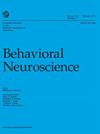Quantifying the inverted U: A meta-analysis of prefrontal dopamine, D1 receptors, and working memory.
IF 1.5
4区 医学
Q3 BEHAVIORAL SCIENCES
引用次数: 0
Abstract
Dopamine in the prefrontal cortex can be disrupted in human disorders that affect cognitive function such as Parkinson's disease (PD), attention-deficit hyperactivity disorder (ADHD), and schizophrenia. Dopamine has a powerful effect on prefrontal circuits via the D1-type dopamine receptor (D1DR). It has been proposed that prefrontal dopamine has "inverted U-shaped" dynamics, with optimal dopamine and D1DR signaling required for peak cognitive function. However, the quantitative relationship between prefrontal dopamine and cognitive function is not clear. Here, we conducted a meta-analysis of published manipulations of prefrontal dopamine and the effects on working memory, a high-level executive function in humans, primates, and rodents that involves maintaining and manipulating information over seconds to minutes. We reviewed 646 articles and found that 75 studies met criteria for inclusion. Our quantification of effect sizes for dopamine, D1DRs, and behavior revealed a negative quadratic slope. This is consistent with the proposed inverted U-shape of prefrontal dopamine and D1DRs and working memory performance, explaining 10% of the variance. Of note, the inverted quadratic fit was much stronger for prefrontal D1DRs alone, explaining 26% of the variance, compared to prefrontal dopamine alone, explaining 10% of the variance. Taken together, these data, derived from a variety of manipulations and systems, demonstrate that optimal prefrontal dopamine signaling is linked with higher cognitive function. Our results provide insight into the fundamental dynamics of prefrontal dopamine, which could be useful for pharmacological interventions targeting prefrontal dopaminergic circuits, and into the pathophysiology of human brain disease. (PsycInfo Database Record (c) 2022 APA, all rights reserved).量化倒U:前额叶多巴胺、D1受体和工作记忆的荟萃分析。
前额叶皮层中的多巴胺可能会在影响认知功能的人类疾病中被破坏,比如帕金森病(PD)、注意力缺陷多动障碍(ADHD)和精神分裂症。多巴胺通过d1型多巴胺受体(D1DR)对前额叶回路有强大的影响。有人提出,前额叶多巴胺具有“倒u型”动态,认知功能峰值需要最佳多巴胺和D1DR信号。然而,前额叶多巴胺与认知功能之间的定量关系尚不清楚。在这里,我们对已发表的前额叶多巴胺的操纵及其对工作记忆的影响进行了meta分析。工作记忆是人类、灵长类动物和啮齿动物的一种高级执行功能,涉及在几秒到几分钟内维持和操纵信息。我们回顾了646篇文章,发现75篇研究符合纳入标准。我们对多巴胺、D1DRs和行为的效应量的量化显示为负二次斜率。这与提出的前额叶多巴胺、d1dr和工作记忆表现的倒u形一致,解释了10%的差异。值得注意的是,与单独的前额叶多巴胺相比,前额叶d1dr的倒二次拟合更强,解释了26%的方差,而前额叶多巴胺单独解释了10%的方差。综上所述,这些来自各种操作和系统的数据表明,最佳的前额叶多巴胺信号与更高的认知功能有关。我们的研究结果提供了对前额叶多巴胺基本动态的深入了解,这可能有助于针对前额叶多巴胺能回路的药物干预,以及人类大脑疾病的病理生理学。(PsycInfo Database Record (c) 2022 APA,版权所有)。
本文章由计算机程序翻译,如有差异,请以英文原文为准。
求助全文
约1分钟内获得全文
求助全文
来源期刊

Behavioral neuroscience
医学-行为科学
CiteScore
3.40
自引率
0.00%
发文量
51
审稿时长
6-12 weeks
期刊介绍:
Behavioral Neuroscience publishes original research articles as well as reviews in the broad field of the neural bases of behavior.
 求助内容:
求助内容: 应助结果提醒方式:
应助结果提醒方式:


